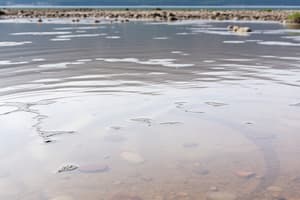Podcast
Questions and Answers
What percentage of the Earth's surface is water?
What percentage of the Earth's surface is water?
- 97%
- 50%
- 71% (correct)
- 29%
What percentage of the Earth's water supply is in the ocean?
What percentage of the Earth's water supply is in the ocean?
- 3%
- 70%
- 97% (correct)
- 50%
What percentage of the Earth's water supply is available as fresh water?
What percentage of the Earth's water supply is available as fresh water?
- 2%
- 5%
- 1% (correct)
- 3%
Why is the ocean water unfit for human consumption?
Why is the ocean water unfit for human consumption?
What is true about pure water?
What is true about pure water?
Why is there no such thing as 'pure water' in nature?
Why is there no such thing as 'pure water' in nature?
What is an important characteristic of water?
What is an important characteristic of water?
What is the main reason for water shortages in the past?
What is the main reason for water shortages in the past?
What is the main cause of millions of deaths every year?
What is the main cause of millions of deaths every year?
What is the importance of water in human life?
What is the importance of water in human life?
What is one of the parameters used to measure water quality?
What is one of the parameters used to measure water quality?
What determines the size of the various units in a water treatment plant?
What determines the size of the various units in a water treatment plant?
What is the design capacity of a water treatment plant based on?
What is the design capacity of a water treatment plant based on?
What is used to forecast population for water demand?
What is used to forecast population for water demand?
What determines which unit operations and processes are to be provided for a water treatment plant?
What determines which unit operations and processes are to be provided for a water treatment plant?
What is the purpose of forecasting population in water treatment plant design?
What is the purpose of forecasting population in water treatment plant design?
What is the purpose of measuring biochemical oxygen demand (BOD) in water?
What is the purpose of measuring biochemical oxygen demand (BOD) in water?
What is one of the factors that determines the hydraulic design of a water treatment plant?
What is one of the factors that determines the hydraulic design of a water treatment plant?
What is a measure of the cloudiness or haziness of water?
What is a measure of the cloudiness or haziness of water?
What is the purpose of determining the per capita water usage?
What is the purpose of determining the per capita water usage?
What is water pollution?
What is water pollution?
What is a point source of water pollution?
What is a point source of water pollution?
What is a non-point source of water pollution?
What is a non-point source of water pollution?
Who sets the Drinking Water Standards in the US?
Who sets the Drinking Water Standards in the US?
What are Primary Drinking Water Standards?
What are Primary Drinking Water Standards?
What are Secondary Standards of drinking water?
What are Secondary Standards of drinking water?
Which of the following is a type of contaminant regulated by Primary Drinking Water Standards?
Which of the following is a type of contaminant regulated by Primary Drinking Water Standards?
Which of the following is a type of contaminant regulated by Secondary Standards of drinking water?
Which of the following is a type of contaminant regulated by Secondary Standards of drinking water?
What is the main purpose of setting drinking water standards?
What is the main purpose of setting drinking water standards?
What is the result of water pollution?
What is the result of water pollution?
What is the main assumption in the Geometric Increase Method (GIM)?
What is the main assumption in the Geometric Increase Method (GIM)?
Which type of city is the Geometric Increase Method (GIM) applicable to?
Which type of city is the Geometric Increase Method (GIM) applicable to?
What is the formula to calculate the population at the end of n years or decades using the Geometric Increase Method (GIM)?
What is the formula to calculate the population at the end of n years or decades using the Geometric Increase Method (GIM)?
What is the main assumption in the Arithmetic Increase Method (AIM)?
What is the main assumption in the Arithmetic Increase Method (AIM)?
Which type of city is the Arithmetic Increase Method (AIM) applicable to?
Which type of city is the Arithmetic Increase Method (AIM) applicable to?
What is the formula to calculate the population after n decades using the Arithmetic Increase Method (AIM)?
What is the formula to calculate the population after n decades using the Arithmetic Increase Method (AIM)?
If the percentage increase in population from decade to decade is increasing, what type of city is it?
If the percentage increase in population from decade to decade is increasing, what type of city is it?
What does the term 𝑥̅ represent in the Geometric Increase Method (GIM)?
What does the term 𝑥̅ represent in the Geometric Increase Method (GIM)?
What is the main difference between the Geometric Increase Method (GIM) and the Arithmetic Increase Method (AIM)?
What is the main difference between the Geometric Increase Method (GIM) and the Arithmetic Increase Method (AIM)?
When is the Arithmetic Increase Method (AIM) used?
When is the Arithmetic Increase Method (AIM) used?
Flashcards are hidden until you start studying
Study Notes
Water Pollution
- Water is the most important natural resource and the second most important constituent of life-support systems.
- 71% of the Earth's surface is water, and 29% is land.
- 97% of the Earth's water supply is in the ocean, which is unfit for human consumption due to its high salt content.
- Only 1% of the Earth's water is fresh and available for human consumption.
Pure Water and Impurities
- Pure water is colorless, tasteless, and odorless.
- Water is an excellent solvent that can dissolve most minerals it comes into contact with.
- There is no such thing as "pure water" in nature, as it always contains chemical and biological impurities.
Water Pollution Definition and Sources
- Water pollution is the presence of impurities in such quantity and nature that it impairs the use of water for designated purposes.
- Point sources of water pollution are specific sites that directly discharge effluents into water bodies, such as industries, power plants, and offshore oil wells.
- Non-point sources of water pollution are scattered and include surface run-off from agricultural fields, overflowing small drains, and atmospheric deposition.
Water Quality Standards
- The US Environmental Protection Agency (EPA) sets drinking water standards for drinking water.
- Primary drinking water standards are enforceable and limit the levels of contaminants in drinking water, including inorganic chemicals, agricultural pesticides, organic chemicals, radionuclides, and microorganisms.
- Secondary standards are non-enforceable guidelines that establish recommendations for contaminants that may cause cosmetic effects or aesthetic effects.
Measurement of Water Quality
- Water quality is measured by parameters such as dissolved oxygen, biochemical oxygen demand, chemical oxygen demand, total organic carbon, turbidity, color, taste, and odor, pH, alkalinity, solids, nitrogen and phosphor, pathogens, and heavy metals.
Water Treatment Plant
- The design of a water treatment plant requires knowledge of the quantity of water to be provided, the quality of the untreated or raw water, and the quality required for the product water.
- The quantity of water to be provided determines the size of the various units and processes to be provided.
Water Demand Forecasting
- Water demand forecasting is necessary to determine the design capacity of a water treatment plant.
- Forecasting methods include geometric increase method, arithmetic increase method, incremental increase method, decrease rate of growth method, graphical extension method, and graphical comparison method.
- Geometric increase method is used for young and rapidly growing cities, while arithmetic increase method is used for old and large cities with no more industrial growth.
Studying That Suits You
Use AI to generate personalized quizzes and flashcards to suit your learning preferences.




